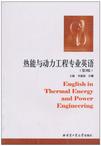热能与动力工程专业英语
2004-7
哈尔滨工业大学出版社
李瑞扬,吕薇 编
398
热能与动力工程专业英语一书自2000年1月出版以来,受到了广大高校师生和英语爱好者的欢迎,目前国内已有多所高等院校将此书作为教材,并在教学中收到良好效果。还有许多热工人员将此书作为科研工作中翻译英文资料的重要参考书。本书出版以来已修订2次,重印6次,读者反馈意见较好,为了进一步满足教学要求和读者需要,增强本书的科学性和实用性,综合各校使用的情况,结合我们多年来的教学经验和体会,在保证本书基本体系和主要内容不变的前提下,在第2版基础上作了如下补充和修改。 (1)为更方便读者阅读和查阅单词,在每课课文后补充了单词表,而全书后词汇索引表(按字母顺序排列)仍保留。 (2)为突出内容的完整性,在内容编排上进行了适当增减和调整,充实了能突出反映本学科相关的内容。 (3)对各课生词及译文进行了核准。 由于参与修订本书的人员及分工有变,书的各章节的负责人员、主编、主审等发生变化。全书由英文、译文和附录组成,英文部分共分七部分,其中第一部分、第六部分由赵玉晓编写,第三部分、第四部分由吕薇编写,第二部分由夏新林编写,第五部分、第七部分及附录等由李瑞扬编写。全书由李瑞扬、吕薇主编,由朱群益主审。 由于编者水平有限,对书中的不足之处,请广大读者批评指正。
《热能与动力工程专业英语(第3版)》涵盖了热能与动力工程专业的主要分支学科,以培养热能与动力工程专业学生的专业英语阅读能力为主要目标。全书共分八个部分.主要内容为:流体力学与流体机械,热力学与传热,燃料及燃烧,制冷与空调,锅炉设备,涡轮机,环保、腐蚀,部分参考译文等,书后附录中还给出了常用缩写词和常用计量单位换算。《热能与动力工程专业英语(第3版)》有较强的实用性和知识性,高等院校热能与动力工程专业的本科生和研究生可根据其选修方向有针对性地学习相关单元。 《热能与动力工程专业英语(第3版)》既可作为高等学校热能与动力工程专业学生的专业英语教材,也可供从事有关热能与动力工程专业的工程技术人员学习、参考之用。
1 Fluid Mechanics and Fluid Machines1.1 Definition of a Fluid and Classification of Fluid Flow1.2 Historical Development of Fluid Mechanics1.3 The Characteristics of Fluids1.4 Scope Significance and Trend of Fluid Mechanics1.5 The Principles of Fluid Machines1.6 Tmbulent Flow2 Thermodynamics and Heat Transfer2.1 Basic Concepts of Thermodynamics2.2 Tbermodynamics Systems2.3 General Characteristics of Heat Transfer2.4 Conduction2.5 Natural Convection2.6 Radiation3 Fuels and Combustion3.1 Heat of Combustion3.2 Combustion Equipment3.3 Fuel-ash3.4 The Mechanisms of Gaseous Fuels Combustion3.5 The Combustion of Liquid Fuels and Solid Fuels3.6 Nuclear Fuels3.7 Liquid By-product Fuels4 Refrigeration and Airconditioning4.1 The Ideal Basic Vapor Compression Refrigeration Cycle4.2 Refrigerant Evaporators4.3 Refrigeration4.4 Absorption Heat Pumps4.5 Comfort and Discomfort4.6 Compressor Failure4.7 Operation and Maintenance of the Aireonditioning Plant4.8 Air-conditioning cycle equipment5 Boiler5.1 Boiler and Its Development5.2 Stokers5.3 Boiler Circulation5.4 Fossil-fuel Boilers for Eleetrie Utilities5.5 Spreader Stoker5.6 Economizers and Air Heaters5.7 Selection of Coal-burning Equipment5.8 Oil and Gas Burning Equipment5.9 Furnace5.10 Gas and Fuel Oil - fired Furnaces5.11 Boiler Design5.12 Superheaters and Reheaters6 Turbine6.1 Steam Turbine6.2 Gas Turbine6.3 Compressor6.4 Gas Turbine Plants6.5 Classification of Steam Turbines6.6 Current Practice and Trends of Turbine6.7 The Modem Steam Power Plant6.8 Wind Turbines6.9 The Principle of Steam Turbine7 Environmental Protection, Corrosion and Others7.1 Ash Removal and Disposal7.2 Oil-ash Corrosion7.3 Control 0fPollutant Gases7.4 Fans7.5 Stokers7.6 Flue Gas Desulfunzation7.7 Steam Separation7.8 Pulverizers7.9 Prevention 0f Scaling in Boilers7.10AirPollution7.11 Pressure Measurement7.12 Clean Coal Teachnologies参考译文流体的定义和流体流动的分类(1.1)流体力学发展史(1.2)热力系统的基本概念(2.1)导热(2.4)液体燃料的燃烧(3.5)核燃料(3.6)液态副产品燃料(3.7)理想的基本蒸气压缩制冷循环(4.1)吸收式热泵(4.4)压缩机故障(4.6)锅炉水循环(5.3)电力公用事业电站燃用矿物燃料的锅炉(5.4)燃油燃气锅炉炉膛设计(5.10)过热器和再热器(5.12)汽轮机(6.1)燃气轮机(6.2)除灰及灰的处理(7.1)油灰腐蚀(7.2)压力测量(7.11)洁净煤技术(7.12)Words and Expressions附录I 常用缩写词附录Ⅱ 常用计量单位换算
An adequate flow of water and water-steam mixture is necessity for steam generation and control of tube metal temperatures in all the circuits of a steam-generating unit. At supereritical pressures, this flow is produced mechanically by means of pumps. At subcritical pressure, s, circulation is produced either naturally by the action of the fiorce of gravity, by pumps, or by a combination of the two. The force of gravity available to produce flow in natural circulation comes from the difference between the densities (lb/cu it) of the fluids in the downcomer (downflow) and riser (upflow) portions of the circuit (Fig. 5. 3 ). Maximum pumping effect occurs if the fluid in the downcomers is water at or slightly below saturation temperature and free of steam bubbles. Heat-absorbing risers at saturation temperature convey to the boiler drum a water-steam mixture of less density than that of the water in the downcomers. This difference in density establishes the force available for circulation. The flow in the various circuits of boiler units designed for forced circulation at subcritical pressures, is produced by mechanical pumps. There are two general types of forced-cireulation systems, a “once-through” system and a “recirculating” system. ……

这个商品不错,正版印刷~
很好,就是没有介绍啊
不错不错,书挺好的,物超所值
很满意!都是正版书!还会再来购买!
正版,便宜,很不错,赞一个!
不错,帮同学买的书。
8号下单,13号才收到,物流上查不到信息